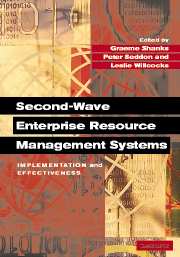Book contents
- Frontmatter
- Contents
- List of Contributors
- Introduction: ERP – The Quiet Revolution?
- Part I Implementation and Effectiveness: Overview
- Part II From Risks to Critical Success Factors
- 5 Enterprise System Implementation Risks and Controls
- 6 Risk Factors in Enterprise-wide/ERP Projects
- 7 A Framework for Understanding Success and Failure in Enterprise Resource Planning System Implementation
- 8 Critical Success Factors Revisited: A Model for ERP Project Implementation
- 9 Offsetting ERP Risk through Maintaining Standardized Application Software
- Part III From Learning to Knowledge
- Part IV Cultural Aspects of Enterprise Systems
- Part V Future Directions
- Index
- References
5 - Enterprise System Implementation Risks and Controls
from Part II - From Risks to Critical Success Factors
Published online by Cambridge University Press: 05 February 2012
- Frontmatter
- Contents
- List of Contributors
- Introduction: ERP – The Quiet Revolution?
- Part I Implementation and Effectiveness: Overview
- Part II From Risks to Critical Success Factors
- 5 Enterprise System Implementation Risks and Controls
- 6 Risk Factors in Enterprise-wide/ERP Projects
- 7 A Framework for Understanding Success and Failure in Enterprise Resource Planning System Implementation
- 8 Critical Success Factors Revisited: A Model for ERP Project Implementation
- 9 Offsetting ERP Risk through Maintaining Standardized Application Software
- Part III From Learning to Knowledge
- Part IV Cultural Aspects of Enterprise Systems
- Part V Future Directions
- Index
- References
Summary
Introduction
Some organizations report success and significant process gains resulting from enterprise system implementation, while many others encounter significant losses. It is readily apparent that the implementation of packaged enterprise system software, and associated requisite changes in business processes, has proved not to be an easy task. As many organizations have discovered, the implementation of enterprise systems can become a recipe for disaster unless the process is carefully handled. The following headlines provide a glimpse of the troubles encountered by organizations, ‘SAP: Whirlpool's Rush to Go Live Led to Shipping Snafus’ (Collett, 1999), ‘Delays, Bugs, and Cost Overruns Plague PeopleSoft's Services’ (Olsen, 1999) ‘ERP Project Leads to Court Fight’ (Stedman, 1999) and ‘PeopleSoft Problems Persist, Cleveland State Looks for a New Project Manager’ (Olsen, 2000). In 1995, US firms incurred an estimated $59 million in cost overruns on information system projects and another $81 million on cancelled software projects (Johnson, 1995). Furthermore, it is estimated that approximately 90% of enterprise system implementations are late or over budget (Martin, 1998).
Enterprise system (ES) implementations are different from ‘traditional’ system analysis and design projects (Davenport, 2000). Among the significant differences are the scale, complexity, organizational impact, and the costs of ES projects and subsequent business impact if the project does not succeed. An ES implementation impacts the entire organization, whereas a traditional project impacts often only a limited area of the organization. Furthermore, ES projects are often associated with the reengineering of business practices.
- Type
- Chapter
- Information
- Second-Wave Enterprise Resource Planning SystemsImplementing for Effectiveness, pp. 135 - 156Publisher: Cambridge University PressPrint publication year: 2003
References
- 4
- Cited by

